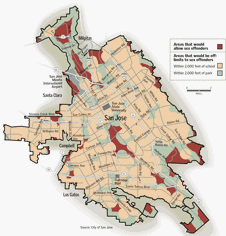The picture on the left is cropped from an image of a man sexually abusing children in Vietnam and Cambodia in 2002 or 2003. The face was digitally scrambled, and the image posted to the Net along with about 200 others. The picture on the right is the same picture, digitally unscrambled by Germany’s federal police. Interpol has posted four unscrambled images of the man’s face on their website, and have asked the public at large for help in identifying him. They’ve already reportedly received hundreds of tips.
That part’s pretty cool, and I hope they catch the guy, but I have some trepidation at the idea of casting such a wide net using just a few photographs. Say you know somebody who looks remarkably like this guy — maybe that creepy guy you see on the subway every morning. How likely is it that he really is they guy they’re looking for?
If you were looking for a local criminal, say someone who robbed the neighborhood 7-11, it would probably be pretty likely you’d found the right guy. After all, it’s pretty darned rare for two unrelated people to look so similar that even after close inspection you mistake one for another. The trouble is, even a very rare event becomes extremely likely when you’re sampling the entire world: if there’s only a one-in-a-hundred-million chance that two randomly-chosen people look really similar, then every person on the planet has approximately 67 doppelgangers running around. It’s not that we can’t distinguish between those one-in-a-hundred-million pairs, it’s just that our brains only specialize our ability to recognize things as far as necessary. That’s why people from another part of the world “all look alike” until you actually start to live with them, and why it becomes trivial to distinguish between ‘identical’ twins once you’ve known them for a couple months. But nobody’s brain is specialized enough to distinguish between one-in-a-hundred-million chance similarity, because it never comes up in our lives.
Interpol seems to recognize they’re taking a risk in publishing these photos, and they caution that law enforcement would have to positively identify any suspects (with additional photos and corroborating data at their disposal). Still, I see two risks where innocent look-alikes could get caught up in this. The first is that, regardless of the advice to wait for positive ID, people are naturally going to be suspicious of any look-alike, and may take action. Though fear of terrorism now tops the list, fear of child molesters in our midst will always be right up there in terms of emotion-stirring boogiemen. The second, even more dangerous risk, is that Interpol itself will try to apply their usual “one-in-a-million” criteria for reasonable doubt to a one-in-a-hundred-million situation. That, I’d argue, would repeat the fiasco the FBI created when they arrested a Portland lawyer for the Madrid bombing, based on a close partial-fingerprint match and (presumably) the fact that he was Muslim.


